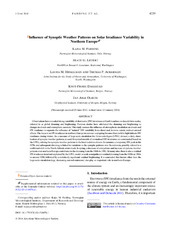Influence of synoptic weather patterns on solar irradiance variability in northern Europe
Parding, Kajsa; Liepert, Beate G.; Hinkelman, Laura M.; Ackerman, Thomas P.; Dagestad, Knut-Frode; Olseth, Jan Asle
Peer reviewed, Journal article
Published version

Åpne
Permanent lenke
https://hdl.handle.net/1956/15663Utgivelsesdato
2016-05Metadata
Vis full innførselSamlinger
- Geophysical Institute [1198]
Originalversjon
https://doi.org/10.1175/jcli-d-15-0476.1Sammendrag
Observations have revealed strong variability of shortwave (SW) irradiance at Earth’s surface on decadal time scales, referred to as global dimming and brightening. Previous studies have attributed the dimming and brightening to changes in clouds and atmospheric aerosols. This study assesses the influence of atmospheric circulation on clouds and SW irradiance to separate the influence of ‘‘natural’’ SW variability from direct and, to some extent, indirect aerosol effects. The focus is on SW irradiance in northern Europe in summer and spring because there is little high-latitude SW irradiance during winter. As a measure of large-scale circulation the Grosswetterlagen (GWL) dataset, a daily classi- fication of synoptic weather patterns, is used. Empirical models of normalized SW irradiance are constructed based on the GWL, relating the synoptic weather patterns to the local radiative climate. In summer, a temporary SW peak in the 1970s and subsequent dimming is linked to variations in the synoptic patterns over Scandinavia, possibly related to a northward shift in the North Atlantic storm track. In spring, a decrease of anticyclonic and increase of cyclonic weather patterns over northern Europe contributes to the dimming from the 1960s to 1990. At many sites, there is also a residual SWirradiance trend not explained by the GWL model: a weak nonsignificant residual dimming from the 1950s or 1960s to around 1990, followed by a statistically significant residual brightening. It is concluded that factors other than the large-scale circulation (e.g., decreasing aerosol emissions) also play an important role in northern Europe.
Utgiver
American Meteorological SocietyOpphavsrett
Copyright 2016 the authorsBeslektede innførsler
Viser innførsler beslektet ved tittel, forfatter og emneord.
-
Variable importance: Comparison of selectivity ratio and significance multivariate correlation for interpretation of latent‐variable regression models
Kvalheim, Olav Martin (Journal article; Peer reviewed, 2020)This work examines the performance of significance multivariate correlation (sMC) and selectivity ratio (SR) for ranking variables according to their importance in latent-variable regressions (LVRs) models. Both indices ... -
Variability and change in Received Pronunciation A study of six phonological variables in the speech of television newsreaders
Hannisdal, Bente Rebecca (Doctoral thesis, 2007-04-20) -
Variability in transport of fish eggs and larvae. IV. Interannual variability in larval stage duration of immigrating plaice in the Dutch Wadden Sea
van der Veer, Henk; Bolle, Loes J.; Geffen, Audrey J.; Witte, Johannes IJ. (Peer reviewed; Journal article, 2009-09-18)Larval immigration of plaice Pleuronectes platessa L. into the western Wadden Sea in spring was followed biweekly from 1993 to 2002. For each year (1993 excluded), 150 settling individuals were selected and used for ...
